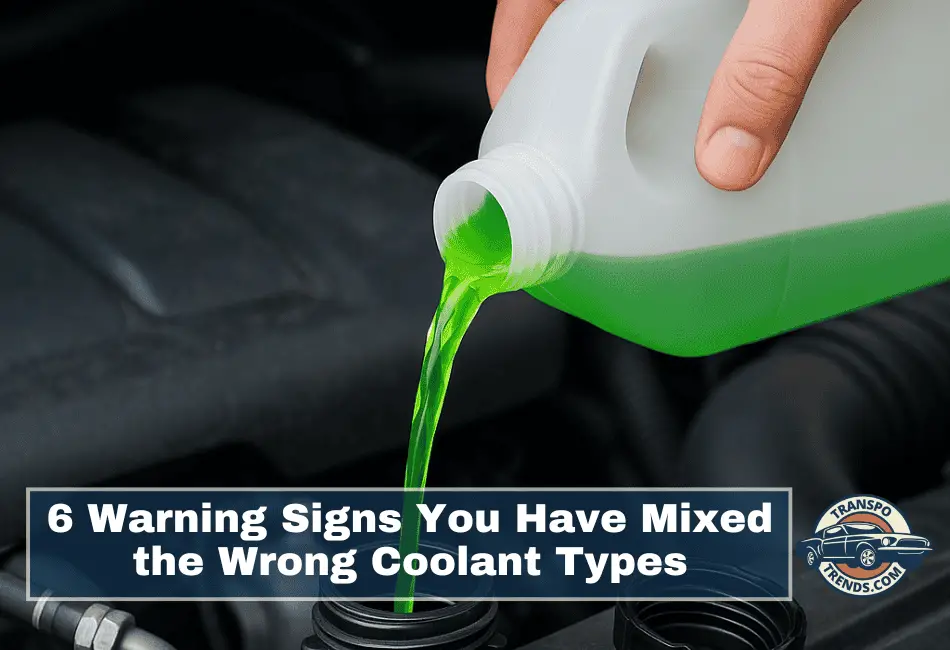Maintaining your car is not just about oil changes and tire rotations. It is also about knowing what goes into your engine—and why it matters. One area drivers often overlook is coolant compatibility.
On the surface, it might not seem like a big deal, but using the wrong type of coolant—or worse, mixing two incompatible kinds—can slowly destroy your engine from the inside out.
Coolant, also called antifreeze, keeps your engine from overheating or freezing, and it prevents corrosion in the process. But all coolants are not created equal.
In fact, combining different types—like the green and pink varieties—can cause serious damage. And here is the scary part: most people do not even realize they have made a mistake until the warning signs begin to surface.
If you are unsure about what is inside your radiator—or if you recently topped off your coolant without checking its type—read on. Here are six clear signs you have mixed incompatible coolants, and what you can do about it before it costs you an engine.
Why Coolant Type Matters
Before we dive into the warning signs, it is important to understand that coolant types are formulated differently.
The green coolant used in older cars is based on Inorganic Additive Technology (IAT), while newer pink or orange coolants typically use Organic Acid Technology (OAT) or Hybrid Organic Acid Technology (HOAT).
Here is a quick reference table:
| Coolant Type | Common Color | Base Technology | Lifespan | Common Use Cases |
|---|---|---|---|---|
| IAT | Green | Inorganic (silicates, phosphates) | ~2 years or 30,000 miles | Older vehicles (pre-1990s) |
| OAT/HOAT | Pink/Orange | Organic acids (silicate-free) | ~5 years or 150,000 miles | Newer vehicles (European, Asian) |
These coolants are designed to work with specific engine materials. Mixing them often results in chemical reactions that reduce performance, corrode components, or even create blockages.
1. You See Sludge or Gel in the Coolant Reservoir
One of the most obvious signs of mixing incompatible coolants is the formation of a thick sludge or gel-like substance.
This occurs because the silicates and phosphates in IAT coolant react negatively with the organic acids in OAT coolant. When combined, they coagulate into a gelatinous mess.
This sludge can clog narrow coolant passages in the radiator or heater core, reducing coolant flow and impairing heat exchange.
If you open your coolant reservoir and see gooey deposits or a brownish, creamy texture—stop driving. Your cooling system is compromised and needs flushing.
2. Your Engine Starts to Overheat
Engines overheat when coolant cannot circulate properly. That is exactly what happens when sludge begins to restrict flow, or when mixed coolants lose their thermal efficiency.
Your dashboard temperature gauge may start to rise more frequently, especially in traffic or during heavy acceleration.
Ignore this for too long, and you risk blowing a head gasket, warping the cylinder head, or even cracking the engine block. Overheating is a late-stage sign, and by the time it happens, damage may already be underway.
3. You Spot Coolant Leaks Under the Vehicle
Mixed coolants can become chemically unstable, weakening the protective inhibitors that prevent corrosion. As corrosion increases, rubber hoses, gaskets, and even your radiator can deteriorate faster than normal.
If you notice colored puddles under your vehicle or your coolant level keeps dropping despite no visible leaks, your system may be leaking from corroded parts. In newer vehicles with aluminum radiators, this kind of damage can become expensive quickly.
4. The Coolant Looks Murky or Off-Color
Coolant is supposed to be bright—green, pink, or orange—depending on the formulation. But when incompatible types are mixed, the liquid often turns cloudy, brownish, or gray.
This change is not just cosmetic. It signals that a chemical reaction has taken place and that your coolant is no longer protecting the system effectively.
If your coolant does not look like it did when it was new, or if you cannot see through it when shining a flashlight into the reservoir, you should consider flushing your system.
5. The Check Engine Light Comes On
Today’s cars are equipped with sensors that detect engine temperature fluctuations and pressure changes in the cooling system.
When the system begins to behave erratically due to coolant incompatibility, your vehicle’s onboard diagnostics may trigger a check engine light.
This warning alone does not confirm mixed coolants—but when combined with other symptoms like overheating or discolored coolant, it becomes a strong indicator.
6. Your Engine Performance Takes a Hit
Even if your vehicle is not overheating visibly, a disrupted cooling system can affect engine performance in subtle ways. You may notice rough idling, delayed acceleration, or a drop in fuel efficiency.
In some cases, you might hear strange sounds as coolant flow becomes restricted and hotspots form inside the engine.
While these symptoms could point to other issues, if they appear after you have changed or topped up coolant, consider compatibility as a potential cause.
What to Do If You Suspect Mixed Coolants
Realizing you have put the wrong coolant into your car can be a stressful moment. But if you act quickly, you can prevent permanent damage. Here is what to do:
Stop Adding More Coolant
Do not attempt to fix the problem by adding more of either type. This can worsen the chemical imbalance and increase the risk of sludge formation.
Consult Your Owner’s Manual
Locate the manufacturer’s recommendation for coolant type. This is your reference point for selecting the correct fluid for a flush and refill.
Perform a Complete Coolant Flush
The only way to restore your system is through a full coolant flush. This involves draining the old coolant, cleaning the system with distilled water or a flushing solution, and refilling it with the correct type.
Let a Professional Handle It
If you see sludge or suspect internal damage, visit a trusted mechanic. They can inspect your radiator, heater core, and water pump for blockages or early-stage corrosion and take steps to restore your engine’s cooling health.
Preventing Coolant Mixing Mistakes
The best way to avoid coolant compatibility issues is to prevent them in the first place. Here are a few practical tips:
- Use the Same Brand and Type: Even within the same base formulation, different brands can have unique additives. Sticking to one brand avoids hidden incompatibilities.
- Do Not Rely on Color Alone: Color can be misleading. Always read the label and confirm the coolant technology (IAT, OAT, or HOAT).
- Label Your Coolant Jug: If you store coolant in your garage, label it clearly with the type and date of opening.
- Schedule Regular Coolant Checks: Review your coolant condition every oil change. Look for discoloration or low levels.
- Use a Universal Coolant When in Doubt: Products like Prestone All Vehicles Coolant are designed to work safely across multiple coolant systems, providing a buffer against accidental mixing.
Visual Comparison: Correct vs. Mixed Coolant Systems
| Component | Correct Coolant | Mixed Coolants |
|---|---|---|
| Radiator | Clear fluid, smooth circulation | Clogged passages from sludge |
| Hoses | Flexible, corrosion-free | Brittle or cracked from internal corrosion |
| Engine Performance | Optimal combustion and temperature | Overheating, rough idling, power loss |
| Coolant Appearance | Bright, transparent color | Murky, thick, or brownish mixture |
A Final Word of Advice
Your vehicle’s cooling system is not just a background player. It is a front-line defender against overheating, corrosion, and costly repairs.
Mixing coolants—even unintentionally—undermines that defense. But the good news is, you can catch the signs early and take action before things spiral out of control.
Whether you maintain your own vehicle or trust a professional, understanding your coolant system is a powerful step toward long-term engine health. Stay informed, stay prepared, and always pour with purpose.

